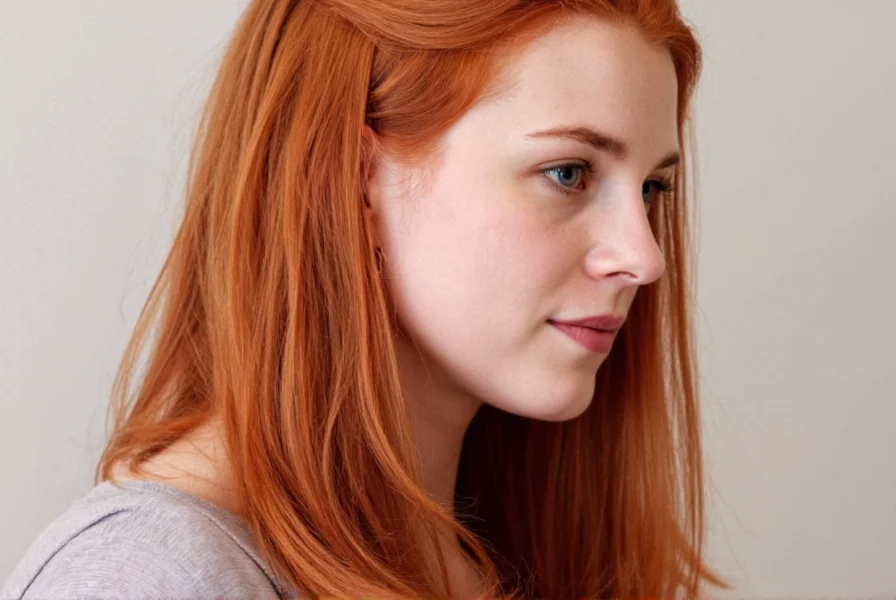Understanding the science behind redhead ginger characteristics reveals fascinating insights about human genetics and diversity. The MC1R (Melanocortin-1 Receptor) gene mutation responsible for red hair follows a recessive inheritance pattern, meaning both parents must carry the variant for their child to express red hair. This explains why red hair can seemingly appear unexpectedly in families without recent redheaded ancestors.
The Genetic Basis of Red Hair
Red hair represents one of the rarest natural hair colors globally, occurring in just 1-2% of the population. The distinctive ginger hair genetics stem from variations in the MC1R gene located on chromosome 16. When this gene functions typically, it produces eumelanin (brown-black pigment). However, specific mutations cause it to produce primarily pheomelanin (red-yellow pigment) instead.
Researchers have identified more than 13 different MC1R variants associated with red hair, explaining the spectrum from bright copper to deep auburn shades. These genetic variations affect not only hair color but also influence multiple physiological characteristics that define the unique traits of redheads.
Physical Characteristics Associated with Red Hair
Natural redheads typically share several physical traits due to their shared genetic profile:
| Characteristic | Scientific Explanation | Prevalence Among Redheads |
|---|---|---|
| Fair skin with freckles | Reduced melanin production increases UV sensitivity | Over 80% |
| Light eye color | Correlated MC1R expression in iris | Approximately 70% |
| Increased pain sensitivity | MC1R affects opioid receptor function | Significantly higher than average |
| Vitamin D efficiency | Adaptive advantage in low-sunlight regions | Nearly universal |
These redhead physical characteristics aren't merely cosmetic. The same MC1R mutation affects multiple body systems, explaining why redheads often require different medical considerations, particularly regarding anesthesia and pain management.
Global Distribution of Red Hair
The red hair prevalence by country follows distinct geographical patterns, with highest concentrations in regions with historically lower sunlight exposure:
- Scotland: Approximately 13% natural redheads, 40% carriers
- Ireland: Around 10% natural redheads, 46% carriers
- Wales: Roughly 8-10% natural redheads
- England: About 4-6% natural redheads
- Northern Europe: 2-4% prevalence
- United States: 2-6% (higher in areas with Celtic ancestry)
This distribution supports the evolutionary theory that the MC1R gene mutation redhead populations developed as an adaptation to environments with limited sunlight, allowing for more efficient vitamin D synthesis despite reduced melanin protection.
Common Misconceptions About Redheads
Despite increased visibility, numerous myths persist about natural redheads characteristics. Scientific research has debunked several common stereotypes:
- Myth: Redheads are going extinct
Fact: While the visible expression may decrease, the recessive gene will continue circulating in populations - Myth: All redheads have green eyes
Fact: Blue eyes are actually more common among redheads than green - Myth: Red hair requires special dying techniques
Fact: Natural redheads often have different hair composition affecting color retention
Practical Considerations for Redheads
Understanding ginger hair care tips can help natural redheads maintain their distinctive color and protect their sensitive features:
Skin Protection
Due to reduced melanin, redheads typically have skin type I or II on the Fitzpatrick scale, requiring rigorous sun protection. Daily broad-spectrum SPF 30+ sunscreen prevents premature aging and reduces skin cancer risk, which is elevated 10-100 times compared to darker-haired individuals.
Hair Maintenance
Natural red hair often has fewer cuticle layers than other hair colors, making it more susceptible to fading. Using color-safe shampoos, avoiding excessive heat styling, and incorporating copper-protecting treatments help maintain vibrancy. Many redheads find that purple-tinted products counteract unwanted brassiness better than blue-toned products.
Medical Awareness
Redheads may require up to 20% more anesthesia during surgical procedures due to MC1R's effect on pain perception pathways. They also tend to be more sensitive to thermal pain and certain medications. Informing healthcare providers about red hair status can lead to better pain management outcomes.
Embracing Red Hair Diversity
The science behind ginger hair represents a beautiful example of human genetic diversity. While redheads face unique challenges, their distinctive traits contribute to the rich tapestry of human variation. Understanding the genetic basis helps combat stereotypes while promoting appreciation for this rare and remarkable phenotype.











 浙公网安备
33010002000092号
浙公网安备
33010002000092号 浙B2-20120091-4
浙B2-20120091-4